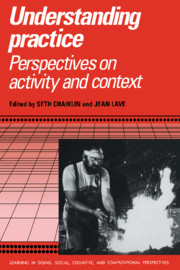Book contents
- Frontmatter
- Contents
- Series foreword
- List of contributors
- Part I Introduction
- Part II Learning craftwork
- Part III Learning as social production
- 8 Examinations reexamined: Certification of students or certification of knowledge?
- 9 Beneath the skin and between the ears: A case study in the politics of representation
- 10 The acquisition of a child by a learning disability
- 11 Context and scaffolding in developmental studies of mother–child problem-solving dyads
- 12 Solving everyday problems in the formal setting: An empirical study of the school as context for thought
- 13 Teacher's directives: The social construction of “literal meanings” and “real worlds” in classroom discourse
- Part IV Conclusion
- Author index
- Subject index
- Learning in Doing: Social, Cognitive, and Computational Perspectives
11 - Context and scaffolding in developmental studies of mother–child problem-solving dyads
Published online by Cambridge University Press: 06 January 2010
- Frontmatter
- Contents
- Series foreword
- List of contributors
- Part I Introduction
- Part II Learning craftwork
- Part III Learning as social production
- 8 Examinations reexamined: Certification of students or certification of knowledge?
- 9 Beneath the skin and between the ears: A case study in the politics of representation
- 10 The acquisition of a child by a learning disability
- 11 Context and scaffolding in developmental studies of mother–child problem-solving dyads
- 12 Solving everyday problems in the formal setting: An empirical study of the school as context for thought
- 13 Teacher's directives: The social construction of “literal meanings” and “real worlds” in classroom discourse
- Part IV Conclusion
- Author index
- Subject index
- Learning in Doing: Social, Cognitive, and Computational Perspectives
Summary
The issue of how adults help children to perform and learn has received a great deal of recent attention. Much of this research stems from the sociohistorical ideas of the late Russian psychologist L. S. Vygotsky (1978, 1934/1986, 1987), especially his conception of the zone of proximal development (zpd). In essence, the zpd represents the child's susceptibility to influence, that is, the difference between what a child can do with assistance and what he or she is able to do without it. It is assumed that most capable adults are able to target appropriately their strategic interactions with children within the latter's zpd, thereby facilitating learning. However, the actual empirical evidence for the relationship between strategic assistance (or scaffolding) and learning is currently somewhat limited and not altogether telling (Levine, Schneider, Pelland, & Hall, 1987).
There are two major problems for those who would interpret the findings from mother–child studies. The first is that there is little consensus about what to look for in the mother–child dyad that would constitute evidence for scaffolding. That is, theory would dictate that some aspect of the joint doing of a task, or verbal (and nonverbal) interaction about and for it, would be what is internalized by the child. The most immediate, and visible, expression of effective scaffolding would be the child's improved performance on the task at hand and/or on a near-transfer task. However, beyond these generalities there is nothing inherent to the theory that would predict just what about the doing of the task, or the talking about it, would lead to learning.
Information
- Type
- Chapter
- Information
- Understanding PracticePerspectives on Activity and Context, pp. 306 - 326Publisher: Cambridge University PressPrint publication year: 1993
Accessibility standard: Unknown
Why this information is here
This section outlines the accessibility features of this content - including support for screen readers, full keyboard navigation and high-contrast display options. This may not be relevant for you.Accessibility Information
- 8
- Cited by
